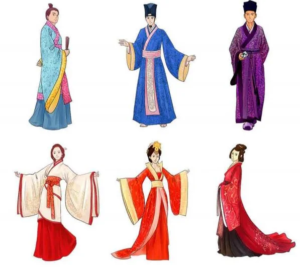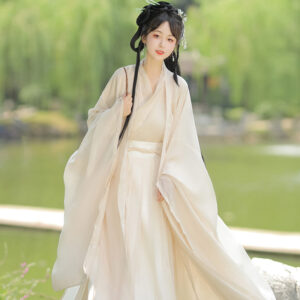
The Yuan Dynasty (1279-1368), established by the Mongols, marked a significant period in the evolution of Hanfu, incorporating elements from Mongolian attire and reflecting the socio-political changes of the time. Here are the distinctive features of Hanfu during this era:
1. Mongolian Influence
- Adoption of Styles: The Yuan Dynasty saw a blending of Han Chinese and Mongolian clothing styles. The traditional Hanfu incorporated features from Mongolian dress, leading to unique silhouettes and designs.
- New Garments: The introduction of the Yuanlingshan, a robe with a high, crossed collar and narrow sleeves, was a notable change. This style catered to the colder northern climate and reflected Mongolian influences.
2. Heavier Fabrics
- Practical Adaptations: Due to the colder climate, heavier fabrics became prevalent. This marked a departure from the lighter materials used in previous dynasties.
- Use of Fur: Fur trims and linings gained popularity, adding warmth and practicality to Hanfu garments, which were once rare in Han Chinese fashion.
3. Color and Patterns
- Vibrant Palette: Bright colors like red, blue, and gold became more popular during the Yuan Dynasty. These colors often held symbolic meanings; for example, red symbolized good fortune, while blue represented purity.
- Elaborate Motifs: Patterns became more intricate, featuring dragons, phoenixes, and floral designs that carried significant cultural weight. The dragon symbolized imperial power, while floral patterns represented nature.
4. Silhouette Changes
- Layering and Length: The silhouette of Hanfu during the Yuan Dynasty included longer robes and additional layers, enhancing practicality for colder weather. This adaptation allowed for greater warmth while maintaining elegance.
- Narrow Sleeves: The transition to narrower sleeves was a significant change from the broader styles of earlier dynasties.
5. Decorative Elements and Accessories
- Intricate Embroidery: Embroidery became prominent, with designs often depicting symbolic motifs such as dragons and lotus flowers. These motifs were not just decorative but also carried deep cultural meanings.
- Accessories: Items like jade belts, ornate headwear, and elaborate footwear complemented the richly decorated garments. Accessories indicated social status and added to the overall aesthetic appeal.
Conclusion
The distinctive features of Hanfu during the Yuan Dynasty reflect a unique blend of cultural influences and practical adaptations to environmental conditions. The incorporation of Mongolian styles, vibrant colors, heavier fabrics, and intricate patterns marked a significant evolution in Hanfu design. This period stands as a testament to the dynamic interplay of tradition, adaptation, and cultural exchange in Chinese fashion history.
Share this post
Recent Posts


What were the key features of Hanfu during the Tang Dynasty?

How did Hanfu styles vary during different Chinese dynasties?

What accessories are typically worn with Hanfu?

How do you choose the right Hanfu for different seasons?

Newsletter
Popular Categories
Related Post
Sed aliquam, tortor et sodales malesuada, lorem leo luctus tellus, quis interdum eros nibh in nunc. Cras dignissim malesuada, lorem leo luctus

What are the winter hanfu called?

What were the key features of Hanfu during the Tang Dynasty?

How did Hanfu styles vary during different Chinese dynasties?


